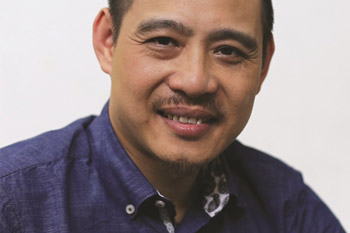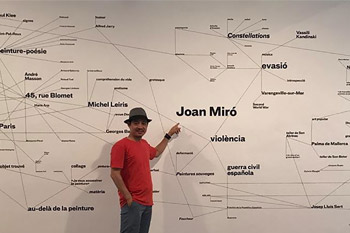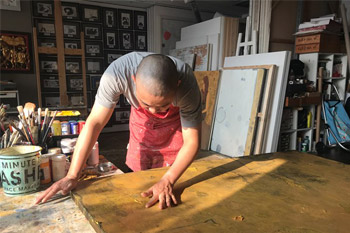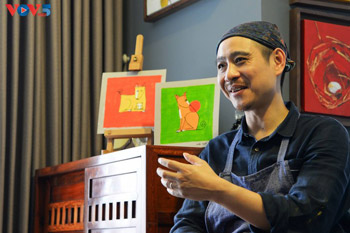PRESS
Artist Pham Ha Hai: The filter and the drops of coffee...
The first time I saw a painting by Pham Ha Hai, it was a lotus painting with green leaves. That image remains the most impressive in my mind whenever I think of Pham Ha Hai.
In a curious exchange about his profession, I asked Pham Ha Hai how he controls his hands when his mind thinks of an image. He replied that the painting itself guides him. And in the same way, regarding his creative direction, Pham Ha Hai philosophized, "I see myself as a coffee filter, and what I paint are drops of coffee..."

Artist Pham Ha Hai
1. Pham Ha Hai was born and raised in Hanoi. Both his parents were civil servants. His older brother, Pham An Hai, is also a famous artist. From a young age, the two brothers explored drawing, much like most men in their extended Pham family who had artistic abilities. Pham Ha Hai's paternal grandfather was a technical graphic artist responsible for designing the entire electrical grid of Hanoi during the French colonial period. His father and siblings were also artists. To this day, all the descendants in their extended family have studied art at various levels, from colleges to universities or through self-study. One of the intriguing aspects of Pham Ha Hai's artistic temperament is that the rural village where he grew up in Hai Duong was known for its fabric dyeing profession, and he believes that these colors have been ingrained in his consciousness.
Every artist has their own creative direction. In fact, this holds true for all forms of art; artists must (and should) strive to find their personal creative direction in order to carve their unique path. The degree of success is uncertain, but it undoubtedly holds a significant place.
Pham Ha Hai's direction is not focused on a straightforward depiction of reality with pure imagery. He believes, "I will be like a coffee filter, and the things I paint are like drops of coffee. It can be understood that the form of the artwork follows the abstract trend of objective world images but fundamentally represents a dialogue between my life and cultural consciousness. This mindset makes me feel that I have a unique affection compared to European abstract artists who follow the rational trend."
2. Pham Ha Hai has left a distinct mark with themes deeply rooted in the East. I believe this is an intelligent choice but not without challenges. When an artist endeavors to take their work beyond borders, the first thing that captures the world's attention is what unique and unseen elements they bring. The East, for centuries, has remained a mystical and captivating land.
Art, perhaps, was the first form of Vietnamese art that could step into the world's largest cultural centers, with paintings valued at hundreds of thousands of dollars – something other art forms have yet to achieve. However, for Pham Ha Hai, the essence of the East presents a challenge, as he resides within it, much like all artists of his time, within a shared cultural sphere, and he must continually strive to distinguish himself.
Pham Ha Hai is passionate about the history of his nation, traditional art forms, sculpture, ceramics, utensils, clothing, music, and folklore. He believes in "journeying to ancient history to meet the contemporary" and, as a result, his paintings always exude a meditative state, evoking subtle and sensitive vibrations influenced by the changes in nature, celestial harmonies, the sounds of the harvest season, and the essence of life. He then combines these inspirations with historical elements to craft his ideas.
The first time Pham Ha Hai introduced his art to the world was in 2001, at the Singapore Art Fair, when he was barely 30 years old. Subsequently, his work has been exhibited in various countries, including Australia, South Korea, Thailand, Indonesia, Japan, Austria, France, the Netherlands, Poland, and, this year, the United States. I believe that the further artists travel from their roots, the more intense the emotions they experience when looking back at their homeland. This is an intrinsic sensibility for an artist and a moment when one realizes what truly dominates their mental space and emotions.
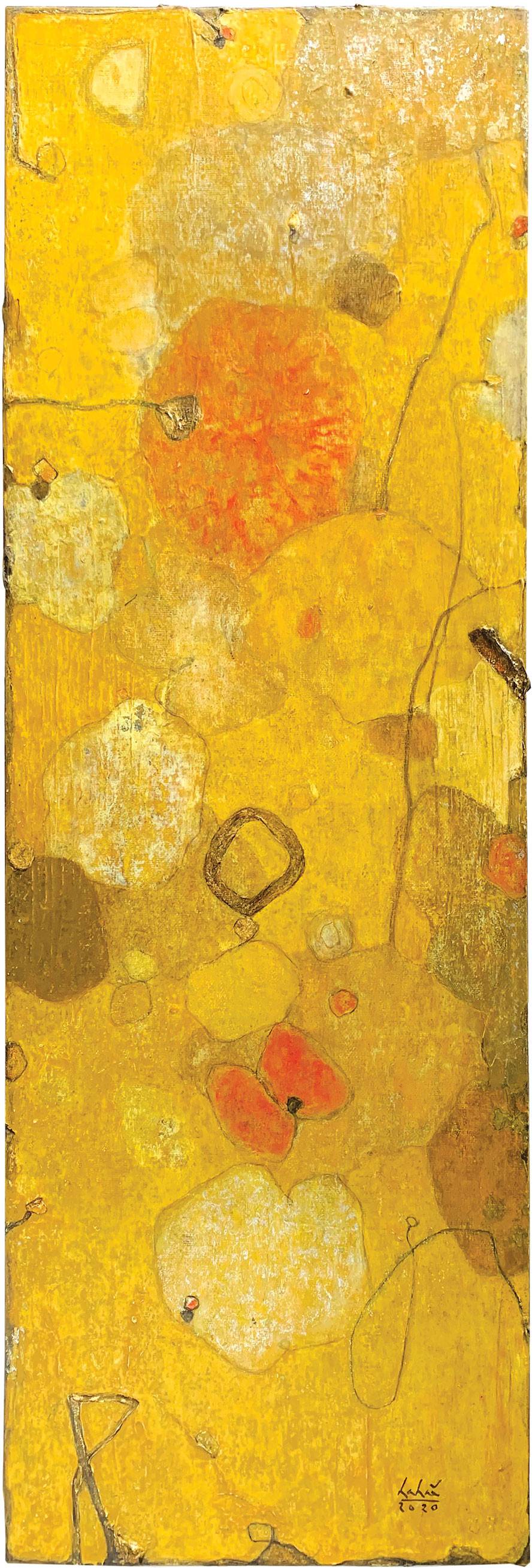
The artwork "Season Diary 03" (created in 2020).
I told Pham Ha Hai that I admired his lotus paintings. They are unmistakably his own interpretation. The lotus is a flower deeply ingrained in Vietnam's culture, and many artists draw inspiration from it. However, Pham Ha Hai brings his unique perspective. His approach tends to be abstract, at times only hinting at details, or the lotus often lies deep within a sense of solitude, desolation, and vastness, even in a field that may be felt but not seen.
Pham Ha Hai states, "Since the painting 'Lake of Lotus' displayed at the National Fine Arts Exhibition in 2005, a relatively large painting (2m x 2m) with a blend of green, gold, and dark brown that represents the surface of water in an abstract style but conveys the sentiment of painting lotus, I realized that I wasn't aiming to depict the natural appearance of a lotus. I wanted to express the space I envisioned. At that time, every stroke and color patch was an abstraction, distilled from the lotus's form but filtered through my psychological structure. And so, for many years, up to this moment, 15 years have passed, I continue with that spirit. The painting 'Harvest' winning the Silver Medal at the National Fine Arts Exhibition in 2015 is an example. It portrays a withered lotus, a beauty that emerges after shedding its colors, much like an ancient sage cherished for their inner qualities."
3. Pham Ha Hai works with various materials and techniques, such as watercolors, handmade paper, oil paint, lacquer, acrylic, and more. He believes that experimenting with different materials is crucial for artists, as good materials and techniques help them effectively convey their aesthetic ideas. Quality materials ensure the longevity of a painting. However, recently, he has presented to the public works created with an entirely new technique called "Acrylic grinding on canvas."
This idea emerged in 2017 when he wanted to capture his emotions regarding the beauty of ancient Vietnamese ceramics. The grinding technique using acrylic materials was applied to a series of paintings called "Ceramic Shadows," which were introduced in Hanoi and Indonesia in 2018. The acrylic grinding technique creates a sense of dilution, flowing, and blending of colors into smooth layers that are transparent, providing depth that was previously only seen in traditional lacquer paintings. Importantly, the surface of acrylic grinding on canvas remains matte, unlike traditional lacquer paintings. These artworks with this technique have been introduced in several countries over the last three years and have been well-received by art collectors due to their distinct beauty.
Refreshing oneself in all aspects of creative work can be a pressure for artists. This pressure can sometimes be exhausting, even driving some to consider giving up. However, the enthusiasm that comes from a successful renewal motivates artists to push forward even more strongly. With Pham Ha Hai, I believe in the "coffee drops" that he has and will continue to create for this life.
Author: Do Bich Thuy
Source: Nhip Song Ha Noi
